Which Demand Exhibits on Again
Louisiana was the merely region deep inside the Confederacy where Union government implemented experimental Reconstruction policies during the Civil War. The Crescent City served as a prime testing basis for race relations nether the new guild.
Within occupied south Louisiana citizens were torn in their loyalties, goals, and visions for the future. When parts of Louisiana returned to Union control, some residents championed conciliation and cooperation with Wedlock authorities, while other whites just every bit strongly resisted whatsoever evidence of reconciliation and sought vindication for southern deaths and wounded laurels. They advocated white supremacy and the demand for social control within a inverse racial social club.
New Orleanians were especially stubborn in refusing to take defeat and occupation. Because the city roughshod early on and did not suffer from battle, nigh citizens were non driven past desperation to want an stop to the war. They refused to give up hope for a southern victory and thus were reluctant to cooperate with Union forces.
Constitution of 1864
Louisiana responded to President Abraham Lincoln's plan to readmit southern states into the Wedlock by selecting delegates to write a new constitution. The Constitution of 1864 abolished slavery and disposed of Louisiana's old society of rule by planters and merchants, although it did not requite African Americans voting power. It was the first state charter to incorporate Lincoln'southward conciliatory approach and was the leading test case for postwar policy.
Lincoln's Emancipation Annunciation of 1863 did not apply to Union-held territory. Thus, slavery continued in the thirteen Louisiana parishes under Union control. After much debate, delegates to the constitutional convention agreed to cancel slavery without bounty for masters but not to give the vote to black men. The new constitution, still, authorized the state legislature to extend voting rights to black men who fought for the Union, endemic property, or were literate.
The constitution likewise enabled the legislature to establish a costless public school system for all children aged six to 18, with no mention of race. Legislators elected nether the Constitution of 1864 established schools for whites but not for blacks.
A New Racial Order
Initial goals of the African-American civil rights movement of the 1860s did not include the abolitionism of slavery but eventually took on the cause of liberty for all African Americans. Equally the ceremonious rights movement in Louisiana, the earliest civil rights entrada of the Reconstruction era, and the national motion gained forcefulness, African Americans and their white allies escalated their demands to include universal male suffrage and other rights.
Not convinced that former slaves were ready to enter society, the U.s. Congress created the Bureau of Refugees, Freedmen, and Abandoned Lands--commonly called the Freedmen'due south Agency--in 1865. Agents of the bureau tried to solve many of the bug associated with the ending of slavery. Bureau agents worked to solve labor disputes, foreclose reenslavement of former slaves, protect freedpersons from violence, operate schools for blacks, keep old slaves on plantations, and distribute food, clothing, and fuel. Agents served mainly as moderators rather than reformers and could do little to affect postwar social and economical relations. Restricted resources, especially manpower, and lack of initiative kept the Freedmen's Bureau from having much benign impact in Louisiana.
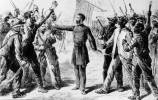 | The Freedmen's Agency Alfred R. Waud July 25, 1868 Reproduced from Harper's Weekly |
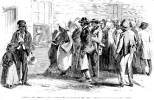 | Glimpses at the Freedman'due south Bureau: Issuing Rations to the Old and Sick James E. Taylor September 22, 1866 Reproduced from Frank Leslie'southward Illustrated Newspaper |
The Blackness Press
Louisiana had the offset black newspaper in the South, L'Union, and the kickoff blackness daily in the nation, the New Orleans Tribune. Working along with other groups and institutions, the free blackness press strove to give vocalisation to and unite the desires of Louisiana African Americans.
 | 50'Wedlock May 12, 1864 Loaned by Gaspar Cusachs |
50'Union was founded in 1862 and circulated as a biweekly and triweekly. Published primarily in French, the paper ran a few problems in English kickoff in 1863. Dr. Louis Charles Roudanez was L'Matrimony's main financier and Paul Trévigne its editor. Both men were prominent leaders in Louisiana's civil rights movement, and under their management, the paper primarily spoke for Louisiana's established community of free people of colour, although also for slaves and newly freed blacks. The newspaper suspended publication on July 19, 1864.
 | Louis Charles Roudanez c. 1870 Reproduced from R. Fifty. Desdunes, Nos Hommes et Notre Histoire |
The New Orleans Tribune was the successor to L'Union when it folded, with Louis Charles Roudanez and Paul Trévigne again at the helm. The Tribune served as a voice for both free and freed African Americans in Louisiana, reflecting the irresolute attitudes of civil rights leaders. The Tribune printed the first page in the French of many free blacks and the reverse in the English language mainly read and spoken by freedpersons. Jean-Charles Houzeau, a white journalist from Kingdom of belgium whom many believed to be of African-American ancestry because of his long association with the civil rights move, replaced Trévigne equally managing editor in November 1864. In 1867 the federal government designated the Tribune an official paper of the United States, 1 of merely 2 in the state given the responsibility of publishing the accurate texts of laws, authoritative announcements, and judicial decisions. The paper was published weekly by 1869 and folded the following twelvemonth.
Getting Out the Vote
The persistent efforts of African Americans and their white allies in Louisiana forced the upshot of voting rights for blacks into the national loonshit. In 1864 they sent a delegation to Washington to petition for enfranchisement. Louisiana blacks valued the right to vote above all other rights because they could not hope to protect their belongings or their lives without political power.
When a petition taken to President Lincoln resulted in no change in the situation, freeborn and newly freed blacks came together at the Convention of Colored Men in January 1865, calling for the organization and unity of all persons of African descent. The convention'south 107 delegates voted to petition commanding military machine regime to integrate streetcars and rejected the idea of extending voting rights to simply a small grouping of black men.
Louisiana Blackness Lawmaking of 1865
Not but did African Americans fail to gain civil and political rights, they also experienced increased regulation over their private lives. To control the behavior and actions of former slaves in the "complimentary" postwar guild, Louisiana and other southern states enacted Black Codes, modeled on restrictions in force under slavery.
The Louisiana Blackness Lawmaking did grant certain rights to freedpersons--to acquire and own property, marry, make contracts, and testify in court--merely its primary purpose was to restore the plantation economy by using blacks as poorly paid laborers instead of outright slaves.
The severity of Louisiana'southward and other states' Black Codes convinced many northerners that only with more than radical forms of Reconstruction would southern society change to accommodate ex-slaves equally citizens and free workers. Congress passed the Ceremonious Rights Human activity of 1866, which defined the rights that all citizens were to bask equally without regard to race: to protect person and holding, make contracts, and bring lawsuits. This federal legislation prevailed over all state laws and revealed the Republican Political party'due south acceptance of what information technology had once considered Radical policy.
Anarchism of 1866
Radical Republicans in Louisiana, both black and white, reacted to the passage of the Black Codes and the legislature's refusal to enfranchise black men by recalling delegates who had written the Constitution of 1864. 20-v white delegates, forth with some two hundred supporters, met for their first day of deliberations on July thirty, 1866, in New Orleans at the Mechanics' Institute, so used every bit the statehouse.
On that same afternoon a group of white citizens, aided by the New Orleans police and firemen, attacked the delegates and their supporters. These white assailants, many of them Confederate veterans, opposed the convention'due south goals and were enraged at the prospects of the new Reconstruction order.
Federal troops were called in to stop the violence but by the time they arrived the commotion had run its course. Official reports from the massacre, i of the bloodiest riots of the Reconstruction era in the United states of america, listed 37 persons (34 black and 3 white Radicals) killed and 146 wounded. Contemporary witnesses believed the numbers to exist much higher.
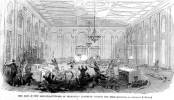 | The Anarchism in New Orleans Harper's Weekly Baronial 25, 1866 This image illustrates the violence in the Mechanics' Institute during the riot |
Radical Reconstruction in Louisiana
Radical Reconstruction in Louisiana was an intense, occasionally violent, competition between those who favored Radical Reconstruction policies and those who fought for white supremacy equally the philosophy that would guide public policy in Louisiana.
Civil rights legislation, as passed and applied in Louisiana, placed the brunt of proof on the injured parties, and with footling national, country, and local protection, African Americans and their white allies found that they had very little power to enforce laws that attempted to erase the color line.
 | Reconstruction! Grand March Charles Young 1868 The cover of this canvas music depicts what many contemporary observers believed about Reconstruction: that the endeavour to enact a new political, economic, and social order was not materializing. |
"Carpetbaggers"--black and white northerners who moved to the Due south after the Ceremonious War--were never in the majority in the 1867-68 Louisiana consitutitional convention or subsequent Reconstruction legislatures. White supremacist opponents of Radical Reconstruction developed and perpetuated the tale of the greedy, corrupt northern "stranger" who stripped Louisiana of its resources.
Most carpetbaggers were former soldiers from middle-class families who went due south seeking a livelihood, not political office. Carpetbaggers who did participate in politics normally did not seize power, as the myth claims, but rather were elected by black and white voters or appointed past Radical Reconstruction officeholders.
 | Carpetbag c. 1870 |
Constitution of 1868
The Constitution of 1868 was one of the best in Louisiana history and at the time was one of the most forward-looking constitutions in the Usa. It extended voting and other civil rights to black males, established an integrated, free public school system, and guaranteed blacks equal admission to public accommodations. The 1868 constitution was also the first one in Louisiana to provide a formal bill of rights. The Black Codes of 1865 were eradicated, as were property qualifications for property part. Writers of the constitution likewise disfranchised former Confederates.
In existent terms the new constitution did little to finish racial discrimination. Although blacks tested antidiscrimination legislation in the courts and authorities occasionally enforced its provisions, the colour line was rarely challenged in Louisiana. Most African Americans could not beget to ride trains and steamboats, attend the opera, or swallow and drink at exclusive clubs, nor could they pay the costs of bringing the offending institutions to court.
Primary Black Leaders
In general, African-American leaders in Louisiana during Reconstruction were very dissimilar from the people they sought to represent. Most were free earlier the Civil War, born in Louisiana, financially secure, and literate. They were skilled workers, businessmen, and professionals, and had owned belongings, including slaves, before the state of war.
 | Extract from the Reconstructed Constitution of the State of Louisiana with Portraits of the Distinguished Members of the Convention and Assembly. A.D. 1868 Gift of Mrs. James Snee |
John Willis Ménard was the outset African American in the United States to speak from the floor of Congress. Although voters in Louisiana elected Ménard to the United States Business firm of Representatives in 1868, Congress contested the election and refused to seat him.
 | Hon. John Willis Menard, Colored Representative from Louisiana in the National Congress December 27, 1868 Reproduced from Frank Leslie'southward Illustrated Paper |
Charles Due east. Nash was the only African American actually to represent Louisiana in the United States Congress during the Reconstruction period. A native of New Orleans, Nash was a stonemason and a former sergeant in the Spousal relationship regular army.
Oscar J. Dunn was the beginning black lieutenant governor of Louisiana, elected in 1868 and serving until his death in 1871. Dunn was born in New Orleans, learned the plasterer'south merchandise, and rose from private to captain in the Matrimony'southward Get-go Louisiana Regiment of black troops.
P. B. S. Pinchback finished Dunn's term every bit lieutenant governor and served as interim governor of the country during the thirty-5 day flow later the country legislature impeached Governor Henry Clay Warmoth. Voters elected Pinchback to the U.s. Congress twice, but he lost his seat both times when challenged past his opponents. Born in Georgia, Pinchback worked every bit a ship's steward prior to the Civil War and commanded a Union Native Guard company during the war. Post-obit Reconstruction, he earned a constabulary degree at Straight University, a blackness university in New Orleans, and accepted a presidential appointment as surveyor of community in New Orleans.
 | Hon. P. B. S. Pinchback, Ex-Lieut. Governor 1873 Detail from Excerpt from the Reconstructed Constitution of the Land of Louisiana with Portraits of the Distinguished Members of the Convention and Assembly. A.D. 1868 Gift of Mrs. James Snee |
Antoine Dubuclet served Louisiana equally state treasurer from 1868 to 1878, the only African American in the reconstructed South to hold that function for more than one term. A sugar planter built-in free in Iberville Parish, Dubuclet was the wealthiest gratis black in Louisiana prior to the Civil State of war.
C. C. Antoine was the third black lieutenant governor of Louisiana, serving from 1872 to 1876. Antoine had served previously every bit a land senator from Caddo Parish and was a planter, barber, and grocery store owner.
Thomy Lafon was active in the Republican party and contributed financially to the civil rights movement. A New Orleans native, Lafon built a fortune as a merchant and real estate investor and left much of his estate to charitable, educational, and cultural institutions that served African Americans.
Master White Leaders
Henry Clay Warmoth, a carpetbagger from Illinois, served as the showtime Reconstruction governor of Louisiana, 1868 to 1872. A mere twenty-five years old when elected, Warmoth at outset held high ideals. He also tried to delight all Louisianians, failing to take a firm stand on many of import issues and alienating much of the population. During his term Warmoth gradually abased the Radical cause, vetoing civil rights legislation, refusing to enforce desegregation of public schools, and appointing Democrats to offices.
 | Henry Clay Warmoth C. Vanni 1870 Gift of Mrs. Henry C. Warmoth |
In the 1872 election both Democrats and Republicans claimed victory, but a federal lath decided in favor of the Republicans, who immediately moved to impeach Warmoth, leaving lieutenant governor Pinchback as acting governor during the last days of Warmoth'southward term.
Thomas Jefferson Durant was one of the few Louisianians who supported Lincoln's presidency in 1860. During federal occupation Durant emerged as the leading spokesperson for the Radical faction, actively campaigning for black voting rights.
William Pitt Kellogg was the country's leading Radical Republican and served as its second Reconstruction governor, 1873-77, a period of intense political turmoil. During his administration Kellogg and the Republican legislature enacted additional civil rights legislation and tried to eradicate abuse and bribery. Kellogg served equally a Usa senator twice and once as a United States representative.
James Madison Wells was elected lieutenant governor in 1864, taking over for Governor Michael Hahn when Hahn was chosen by the land legislature as Louisiana representative to the The states Congress. He was reelected as governor in 1865. Wells was known as a "scalawag," a southern-born white who supported the Republican Party.
Opponents of Reconstruction
Several terrorist organizations sprang up in Louisiana during the Reconstruction era. They primarily aimed to intimidate Republican voters and officeholders of both races, obstruct implementation of Radical Republican policies, and restore Louisiana to rule past native whites.
The main instruments of white terror in Louisiana were the Knights of the White Camellia, formed in 1868, and their successor grouping, the White League, which had spread beyond the state past 1874. The earliest of white supremacy groups was the Ku Klux Klan, formed in Tennessee in 1866, merely testify of the Klan's activity in Louisiana is scanty.
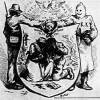 | The Lost Crusade Worse Than Slavery Thomas Nast Oct 24, 1874 Reproduced from Harper's Weekly The artist chides the White League and the Klan for creating conditions "worse than slavery" for freed blacks. |
Whites, many of them Democrats, joined these terrorist organizations when they began losing ability to Radical Republicans, both white and black. The immediate goal of these groups was to keep white and black Republicans away from polling places. Their fierce tactics, targeted at blackness leaders, escalated during Reconstruction. White mobs killed three country legislators during these turbulent times.
Colfax Anarchism
The Colfax Riot was the bloodiest single instance of racial violence in the Reconstruction era in all of the U.s.a.. Disputes over the 1872 election results had produced dual governments at all levels of politics in Louisiana. Fearful that local Democrats would seize ability, former slaves nether the command of black Ceremonious War veterans and militia officers took over Colfax, the seat of Grant Parish, and a massacre ensued, including the slaughter of well-nigh fifty African Americans who had laid down their artillery and surrendered.
Coushatta Massacre
White League influence spread to northwest Louisiana in the summer of 1873. Its roughshod actions targeted whites too every bit blacks. One such episode was directed against the family unit of carpetbagger policitian Marshall Harvey Twitchell. In 1874 the White League, who arrested and executed Twitchell'southward blood brother, two brothers-in-law, and three other white Republicans, while Twitchell was in New Orleans. Twitchell returned to Coushatta from New Orleans with two companies of federal troops, his goal to restore Republican rule in the parish. Autonomous leaders continued to control local politics, however. In 1876 they assassinated Twitchell's blood brother-in-law, and tried to kill Twitchell, who lost both arms in the fray.
 | Marshall Harvey Twitchell c. 1890 Later, Twitchell was fitted with bogus artillery. |
Showtime Battle of the Cabildo
The so-called First Boxing of the Cabildo, fought on March v, 1873, pitted Democrats who supported John McEnery against the Metropolitan Police force of New Orleans, an integrated militia that protected the Republican administration under Governor William Pitt Kellogg. Both candidates had claimed victory in the 1872 ballot and established dual military forces and legislatures, resulting in a McEnery coup effort directed at Metropolitan Police headquarters in the Cabildo. Kellogg and the Republicans maintained power, although their tenure was unstable throughout the remaining years of Reconstruction.
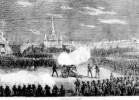 | Mortality at New Orleans--The Police Firing on the Militia and Rioters in Jackson Square March 22, 1873 Frank Leslie's Illustrated Paper |
Battle of Liberty Identify
On September fourteen, 1874 the Metropolitan Law once again clashed with Democratic militia forces, now organized every bit the Crescent City White League, in a disharmonize known as the Battle of Liberty Place. This time the Metropolitan Police, numbering most 600, assisted by an additional 3,000 black militia, lost to the White Leaguers, who numbered about eight,400. Casualties included eleven killed and sixty wounded Metropolitans and sixteen killed and forty-five wounded White Leaguers. Today a controversial monument stands near the site of battle honoring White League members killed in the combat.
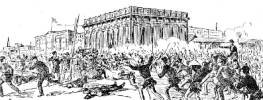 | General Battle Between the Metropolitan Law and Citizens at the Foot of Canal Street September 23, 1874 Reproduced from the New York Daily Graphic |
President Ulysses S. Grant called in federal troops from Mississippi to restore Governor Kellogg to office. They helped maintain Kellogg in power until the end of Reconstruction.
2nd Battle of the Cabildo
Tensions between Radicals and white supremacists climaxed later on the disputed gubernatorial election in 1876, in which both Republican Stephen B. Packard and Democrat Francis T. Nicholls claimed a majority of votes and established dissever governments, just every bit the 1872 candidates had done. In Jan 1877, on the morning time after Nicholls's inauguration, he sent 3,000 men to take the Cabildo, seat of the Louisiana state supreme court and headquarters for the Metropolitan Police. Heavily outmanned, federal and Metropolitan forces offered no resistance. The supreme court justices gave up their courtroom, and Nicholls appointed a new judiciary.
Louisiana "Redeemed"
Political happenings in Washington, however, decided whether the Packard or Nicholls government would triumph. On the national level the ii major parties disagreed over which presidential candidate, Democrat Samuel J. Tilden or Republican Rutherford B. Hayes, had truly won the election of 1876. A compromise worked out in February 1877 provided that disputed votes went to hayes and in exchange Hayes permitted southern Democrats, likewise known equally redeemers, to accept over governments in the three remaining militarily occupied states, Florida, South Carolina, and Louisiana.
Once the federal regime agreed to pull its troops out of Louisiana, the Nicholls administration took over. Packard'southward Republican supporters maintained a shadow government until the cease of April 1877. A mostly Democratic convention wrote a new constitution that voters ratified in 1879, returning Louisiana to "habitation rule," with white supremacist Democrats controlling almost of the state, parish, and municipal institutions.
Conclusion
Although the promise of alter pervaded Louisiana during the era of Reconstruction, few lasting transformations took hold. African Americans were now legally free--a major accelerate for commonwealth and humanitarianism--and for a while at least, black men could vote. Suffrage, nevertheless, just had symbolic value if citizens could not earn plenty to provide basic necessities for their families and had to send their children to substandard, underfunded schools. Few Louisiana blacks and even many whites could purchase their own plot of land, with such economic arrangements as tenant farming, sharecropping, and debt peonage reducing them to continued dependency. Equally a event, many of the ceremonious rights battles fought in the 1860s and 1870s had to be waged again one hundred years afterwards.
mcmanusforyanceir.blogspot.com
Source: https://www.crt.state.la.us/louisiana-state-museum/online-exhibits/the-cabildo/reconstruction-a-state-divided/index
0 Response to "Which Demand Exhibits on Again"
ارسال یک نظر